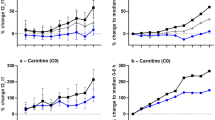Blood plasma proteome in patients with cerebral ischemia and healthy individuals was studied using comparative proteomic analysis based on tandem HPLC-MS/MS. Mass spectra were analysed in an automated mode using Progenesis LS-MS software and 256 proteins were identified. Significant quantitative differences were revealed for 20 proteins. It was found that changes in the blood plasma proteome in subjects with cerebral ischemia involved a wide range of proteins: molecular chaperones, fibrinolysis, angiogenesis, and immune system proteins, proteins involved in homeostasis maintenance, cell differentiation and proliferation, regulators of apoptosis, and cytoskeleton proteins.
Similar content being viewed by others
References
Kisrieva YS, Petushkova NA, Samenkova NF, Kuznetsova GP, Larina OV, Zavialova MG, Teryaeva NB, Belyaev AY, Karuzina II. Comparative proteome analysis of blood plasma of patients with early-stage chronic cerebral ischemia. Biomed. Khimiya. 2016;62(5):599-602. Russian.
Rodchenkova M, Novikova S. Optimization of liquid chromatography with mass spectrometric detection method for the qualitative and semi-quantitative proteomic analysis. Analitika. 2013;3(10):40-47. Russian.
Becker M, Kuhse J, Kirsch J. Effects of two elongation factor 1A isoforms on the formation of gephyrin clusters at inhibitory synapses in hippocampal neurons. Histochem. Cell Biol. 2013;140(6):603-609.
Camins A, Sureda FX, Junyent F, Verdaguer E, Folch J, Beas-Zarate C, Pallas M. An overview of investigational antiapoptotic drugs with potential application for the treatment of neurodegenerative disorders. Expert Opin. Investig. Drugs. 2010;19(5):587-604.
He H, Chen M, Scheffler NK, Gibson BW, Spremulli LL, Gottlieb RA. Phosphorylation of mitochondrial elongation factor Tu in ischemic myocardium: basis for chloramphenicolmediated cardioprotection. Circ. Res. 2001;89(5):461-467.
Hossain MN, Fuji M, Miki K, Endoh M, Ayusawa D. Downregulation of hnRNP C1/C2 by siRNA sensitizes HeLa cells to various stresses. Mol. Cell. Biochem. 2007;296(1-2):151-157.
Hüttemann M, Lee I, Grossman LI, Doan JW, Sanderson TH. Phosphorylation of mammalian cytochrome c and cytochrome c oxidase in the regulation of cell destiny: respiration, apoptosis, and human disease. Adv. Exp. Med. Biol. 2012;748:237-264.
Kuo CC, Liang CM, Lai CY, Liang SM. Involvement of heat shock protein (Hsp)90 beta but not Hsp90 alpha in antiapoptotic effect of CpG-B oligodeoxynucleotide. J. Immunol. 2007;178(10):6100-6108.
Liebelt B, Papapetrou P, Ali A, Guo M, Ji X, Peng C, Rogers R, Curry A, Jimenez D, Ding Y. Exercise preconditioning reduces neuronal apoptosis in stroke by up-regulating heat shock protein-70 (heat shock protein-72) and extracellularsignal-regulated-kinase 1/2. Neuroscience. 2010;166(4):1091-1100.
Ling Q, Jacovina AT, Deora A, Febbraio M, Simantov R, Silverstein RL, Hempstead B, Mark WH, Hajjar KA. Annexin II regulates fibrin homeostasis and neoangiogenesis in vivo. J. Clin. Invest. 2004;113(1):38-48.
Liu Y, Jiang S, Yang PY, Zhang YF, Li TJ, Rui YC. EF1A1/HSC70 cooperatively suppress brain endothelial cell apoptosis via regulating JNK activity. CNS Neurosci. Ther. 2016;22(10):836-844.
Miniño AM, Arias E, Kochanek KD, Murphy SL, Smith BL. Deaths: final data for 2000. Natl Vital Stat. Rep. 2002;50(15):1-119.
Sharp FR, Zhan X, Liu DZ. Heat shock proteins in the brain: role of Hsp70, Hsp 27, and HO-1 (Hsp32) and their therapeutic potential. Transl. Stroke Res. 2013;4(6):685-692.
Stapels M, Piper C, Yang T, Li M, Stowell C, Xiong ZG, Saugstad J, Simon RP, Geromanos S, Langridge J, Lan JQ, Zhou A. Polycomb group proteins as epigenetic mediators of neuroprotection in ischemic tolerance. Sci. Signal. 2010;3(111):ra15. doi: https://doi.org/10.1126/scisignal.2000502.
Author information
Authors and Affiliations
Corresponding author
Additional information
Translated from Byulleten’ Eksperimental’noi Biologii i Meditsiny, Vol. 165, No. 1, pp. 29-33, January, 2018
Rights and permissions
About this article
Cite this article
Kisrieva, Y.S., Petushkova, N.A., Samenkova, N.F. et al. Analysis of Blood Plasma Protein Composition in Patients with Cerebral Ischemia. Bull Exp Biol Med 165, 22–26 (2018). https://doi.org/10.1007/s10517-018-4090-1
Received:
Published:
Issue Date:
DOI: https://doi.org/10.1007/s10517-018-4090-1




